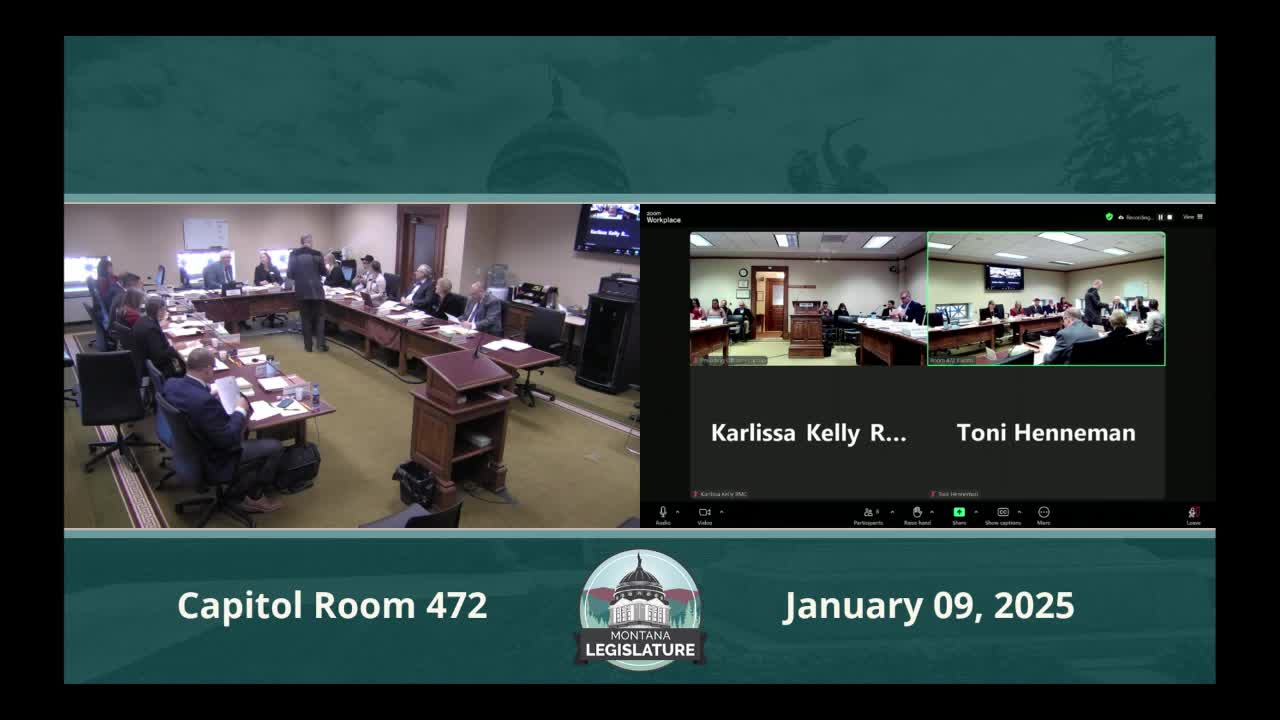Bill would create $100 million Montana resiliency fund to boost federal disaster matching
January 09, 2025 | 2025 Legislature MT, Montana
This article was created by AI summarizing key points discussed. AI makes mistakes, so for full details and context, please refer to the video of the full meeting. Please report any errors so we can fix them. Report an error »

Representative Larry Brewster opened a public hearing on House Bill 34, which would establish a Montana Resiliency Fund seeded with $100,000,000; interest and limited annual spending from the fund would be used to provide state matching funds to help communities secure federal disaster-mitigation grants.
Ryan Evans, assistant budget director for the governor’s budget office, said the proposal expands a temporary pilot and is intended to leverage one-time-only state reserves to attract federal funding and reduce future local property-tax burdens. "This is a good bill. It brings with it a great match. It has the ability to reach across all of Montana into communities," Evans told the committee.
Major General Pete Ronek, director of the Department of Military Affairs, said the pilot program had demonstrated the ability to leverage federal grants and that a larger fund would let Montana maximize federal award opportunities. "On average, each project administered is awarded 75% of the cost under FEMA grant funding," Ronek said, adding that FEMA shares sometimes reach 75% or higher depending on the program.
Delila Bruno, administrator for Montana Disaster and Emergency Services, provided program mechanics: local jurisdictions develop hazard-mitigation plans that identify projects; DES helps prioritize and submit ranked projects to FEMA and other federal programs; the most significant barrier for local applicants is meeting local-match requirements, typically 10–25%. Bruno said the pilot fund helped bring nearly $25,000,000 in projects to Montana communities, and she said the program aims to keep 80–90% of funding directed to construction projects (hardening infrastructure, flood channels, fuels reduction) rather than planning overhead.
Representatives of electric cooperatives and municipal governments and local emergency managers described projects already assisted by the resiliency fund and urged support. Keely Montalban, assistant general manager and chief risk officer for Missoula Electric Cooperative, said projects such as a Rock Creek wildfire mitigation project would not have been feasible without a combination of federal BRIC grants and state resiliency funding.
Local officials from Three Forks described a flood-channel project where the state fund covered a $1.4 million local match that otherwise would have fallen to about 2,000 residents. Witnesses described previous seed funding of $4 million per year in the biennium as a pilot and said the bill’s proposal would allow spending not to exceed $50 million per year while maintaining a $100 million principal.
Committee members asked detailed questions about federal selection times (DES estimated six months to a year for FEMA selection in many cases), how federal priorities and equity considerations affect awards, and applicant eligibility (for example, whether projects on corporate-owned land would qualify depends on ownership, maintenance history and applicant status). Flathead County told the committee it had not applied recently because its local mitigation plan had expired but that a plan was pending FEMA approval.
No opponents spoke at the hearing. The committee closed the hearing without taking formal action at this session.
Ryan Evans, assistant budget director for the governor’s budget office, said the proposal expands a temporary pilot and is intended to leverage one-time-only state reserves to attract federal funding and reduce future local property-tax burdens. "This is a good bill. It brings with it a great match. It has the ability to reach across all of Montana into communities," Evans told the committee.
Major General Pete Ronek, director of the Department of Military Affairs, said the pilot program had demonstrated the ability to leverage federal grants and that a larger fund would let Montana maximize federal award opportunities. "On average, each project administered is awarded 75% of the cost under FEMA grant funding," Ronek said, adding that FEMA shares sometimes reach 75% or higher depending on the program.
Delila Bruno, administrator for Montana Disaster and Emergency Services, provided program mechanics: local jurisdictions develop hazard-mitigation plans that identify projects; DES helps prioritize and submit ranked projects to FEMA and other federal programs; the most significant barrier for local applicants is meeting local-match requirements, typically 10–25%. Bruno said the pilot fund helped bring nearly $25,000,000 in projects to Montana communities, and she said the program aims to keep 80–90% of funding directed to construction projects (hardening infrastructure, flood channels, fuels reduction) rather than planning overhead.
Representatives of electric cooperatives and municipal governments and local emergency managers described projects already assisted by the resiliency fund and urged support. Keely Montalban, assistant general manager and chief risk officer for Missoula Electric Cooperative, said projects such as a Rock Creek wildfire mitigation project would not have been feasible without a combination of federal BRIC grants and state resiliency funding.
Local officials from Three Forks described a flood-channel project where the state fund covered a $1.4 million local match that otherwise would have fallen to about 2,000 residents. Witnesses described previous seed funding of $4 million per year in the biennium as a pilot and said the bill’s proposal would allow spending not to exceed $50 million per year while maintaining a $100 million principal.
Committee members asked detailed questions about federal selection times (DES estimated six months to a year for FEMA selection in many cases), how federal priorities and equity considerations affect awards, and applicant eligibility (for example, whether projects on corporate-owned land would qualify depends on ownership, maintenance history and applicant status). Flathead County told the committee it had not applied recently because its local mitigation plan had expired but that a plan was pending FEMA approval.
No opponents spoke at the hearing. The committee closed the hearing without taking formal action at this session.
View full meeting
This article is based on a recent meeting—watch the full video and explore the complete transcript for deeper insights into the discussion.
View full meeting
